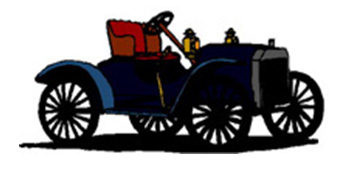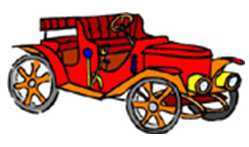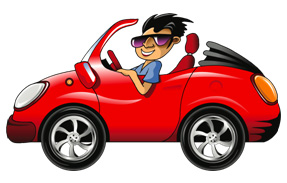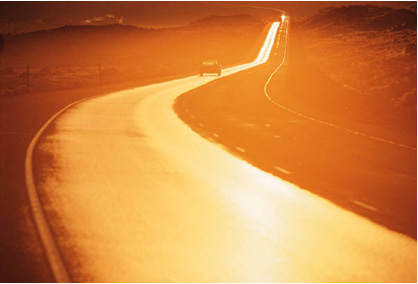The automobile has been around for a little more than 125 years!
Development of the Automobile – Where it all began
 In the 1880’s, Karl Benz installed a small motor on a tricycle and the automobile was born. In 1896, Frank and Charles Duryea built the first American motorcar in Springfield Massachusetts. They manufactured the first of 13 of these gas-powered inventions.
In the 1880’s, Karl Benz installed a small motor on a tricycle and the automobile was born. In 1896, Frank and Charles Duryea built the first American motorcar in Springfield Massachusetts. They manufactured the first of 13 of these gas-powered inventions.
Sociological Changes Caused by the Automobile – The turn of the century (1900’s)
 In 1896, Buffalo New York was the first major city to pave all of its streets. At the turn of the century, 8,000 automobiles were on the road. General Motors incorporated in 1908. The first mile of rural highway was paved. Since more than 40 percent of the work force was involved in farming, rural roads were important links. The first gas station opened in St Louis Missouri at the turn of the century. Speedometers were installed on Oldsmobile automobiles. In 1903 Henry Ford founded the Ford Motor Company. Five years later he introduced the Model T.
In 1896, Buffalo New York was the first major city to pave all of its streets. At the turn of the century, 8,000 automobiles were on the road. General Motors incorporated in 1908. The first mile of rural highway was paved. Since more than 40 percent of the work force was involved in farming, rural roads were important links. The first gas station opened in St Louis Missouri at the turn of the century. Speedometers were installed on Oldsmobile automobiles. In 1903 Henry Ford founded the Ford Motor Company. Five years later he introduced the Model T.
The 1900’s
By 1915, 2.3 million automobiles were registered in the United States. About half of those were Ford’s Model T. Model T’s were affordable, easy to service, and available in any color you wanted as long as that color was black. In 1910, Barney Oldfield set a new speed recorded with a Blitzen-Benz at Daytona Beach Florida, at more than 131 miles an hour. The first Indianapolis 500 race was held in 1911. The Lincoln Highway, the nation’s first coast-to-coast highway, was marked between New York and San Francisco. Carl Fisher spearheaded the effort. He wasn’t the first to have this dream but he figured out how to organize and fund the project. Wisconsin was the first state to assign numbers and letters to roads and highways.
Insurance for automobiles is born
In Westfield Massachusetts, an enterprising mechanic built his own car and then insured it for $1,000 worth of liability. His premium was $7.50.
The Roaring Twenties
 The federal government began a program to pave the way coast to coast. The first highway to connect the coasts was completed in 1927. Americans start “hitting” the road, traveling to National Parks, and making camping an American pastime. The new roads bring a complete transformation to the entire country.
The federal government began a program to pave the way coast to coast. The first highway to connect the coasts was completed in 1927. Americans start “hitting” the road, traveling to National Parks, and making camping an American pastime. The new roads bring a complete transformation to the entire country.
The Automobile and the Future
 The automobile is one of the most important possessions that we own. It gives freedom, education, and financial means. It has changed the entire way this nation looks. It has given us millions of miles of highways to transport our goods. The automobile may change in design, but it is here to stay. The sky is the limit to where we will go with the automobile. We have developed vehicles that run on electricity and solar power in our pursuit of a new source of power. Gasoline emits too much pollution and we are in dire need of a new less harmful solution that is as affordable as Ford’s Model T was to consumers back in the 1920’s.
The automobile is one of the most important possessions that we own. It gives freedom, education, and financial means. It has changed the entire way this nation looks. It has given us millions of miles of highways to transport our goods. The automobile may change in design, but it is here to stay. The sky is the limit to where we will go with the automobile. We have developed vehicles that run on electricity and solar power in our pursuit of a new source of power. Gasoline emits too much pollution and we are in dire need of a new less harmful solution that is as affordable as Ford’s Model T was to consumers back in the 1920’s.
 We will see in the future new inventive ideas that will lead us into the new millennium and beyond. No doubt that these ideas will continue to change the way we think, act and respond. They may even change the way we live.
We will see in the future new inventive ideas that will lead us into the new millennium and beyond. No doubt that these ideas will continue to change the way we think, act and respond. They may even change the way we live.
 Dr. Horatio Jackson, with his chauffeur and dog, was the first person to cross the country in an automobile. It took 65 days to make their journey.
Dr. Horatio Jackson, with his chauffeur and dog, was the first person to cross the country in an automobile. It took 65 days to make their journey.
- Henry Ford’s Model T dropped from $850 in 1908 to $275 in the 1920’s.
- Henry Ford opened up the first assembly line plant to manufacture Model T’s for the masses.
- The first police squad car was put on the road in 1922, to help fight prohibition.
- Highway 66 was born connecting the east with the west. Running from Chicago to Los Angeles.
- The stock market crashes in 1929. America’s $2.9 billion consumer installment debt was linked to automobile purchases.
- In 1931, the 50 millionth American made automobiles rolled off the assembly line. However, the great depression affected the production. Between 1929-1932, production plummeted 75%, and around half of the auto makers were laid off.
- The love for the automobile during the depression compels automobile owners to give up their homes and travel to new locations to find a better life.
- During World War II, gas was rationed and automobile travel was reduced by 40%.
- Rubber for tires was rationed
- In 1941, 3.2 million cars were manufactured.
- In 1945, 84,000 cars were made.
- In 1946, Detroit resumed making cars and the companies could not keep up with the demand.
- By the 1950’s, everyone was on the road.
- The Interstate Highway System, a network of more than 41,000 miles of toll-free superhighways, was inaugurated in 1956.
- Automobile designers take on a futuristic look. Cars become works of art with things like fins, dramatic coloring and chrome trim to catch the eye of the consumer.
- In the 1960’s, the first anti-pollution legislation targeting the motor vehicle emissions was passed.
- Changes occur constantly. The muscle car is introduced, the Pontiac GTO, a triple-carburetor, 350 horsepower V-8 engine.
- The 1970’s saw the German built Volkswagen Beetle become America’s best-selling automobile.
- The oil crisis in the Middle East and shortages in the United States, caused the government to pass a national speed limit of 55 M.P.H. to conserve on gasoline.
- 1974, the first airbags became available to consumers.
- The cost of gasoline goes from $0.45 in 1973 up to $1.31 in 1980, then to $1.43 in 1991.
- Although seatbelts have been installed in vehicles almost since the beginning of the automobile, it took until1984 for the first state to make it law to buckle up. Now almost every state requires drivers and passengers to wear their safety belts.
- Honda was the first Japanese automobile manufacturer to produce cars in the United States.
- In the 1990’s, smart cars were introduced with integrated child safety seats, automatic climate control, remote keyless entry, anti-theft devices, heated windshields, and particulate air filters.
- There are now more than 175 million licensed drivers in the United States; 200 million registered vehicles; and 4 million miles of paved roads and highways.
Where will the automobile take us next?


